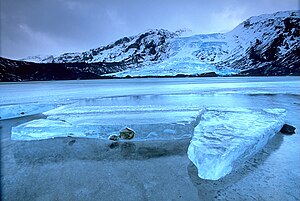The Iceland Portal
Iceland (Icelandic: Ísland, pronounced [ˈistlant] ) is a Nordic island country between the North Atlantic and Arctic Oceans, on the Mid-Atlantic Ridge between North America and Europe. It is culturally and politically linked with Europe and is the region's westernmost and most sparsely populated country. Its capital and largest city is Reykjavík, which is home to about 36% of the country's roughly 380,000 residents (excluding nearby towns/suburbs which are separate municipalities). The official language of the country is Icelandic. Iceland is on a rift between tectonic plates, and its geologic activity includes geysers and frequent volcanic eruptions. The interior consists of a volcanic plateau with sand and lava fields, mountains and glaciers, and many glacial rivers flow to the sea through the lowlands. Iceland is warmed by the Gulf Stream and has a temperate climate, despite a latitude just south of the Arctic Circle. Its latitude and marine influence keep summers chilly, and most of its islands have a polar climate. According to the ancient manuscript Landnámabók, the settlement of Iceland began in 874 AD, when the Norwegian chieftain Ingólfr Arnarson became the island's first permanent settler. In the following centuries, Norwegians, and to a lesser extent other Scandinavians, immigrated to Iceland, bringing with them thralls (i.e., slaves or serfs) of Gaelic origin. The island was governed as an independent commonwealth under the native parliament, the Althing, one of the world's oldest functioning legislative assemblies. After a period of civil strife, Iceland acceded to Norwegian rule in the 13th century. In 1397, Iceland followed Norway's integration into the Kalmar Union along with the kingdoms of Denmark and Sweden, coming under de facto Danish rule upon its dissolution in 1523. The Danish kingdom introduced Lutheranism by force in 1550, and the Treaty of Kiel formally ceded Iceland to Denmark in 1814. (Full article...) Selected article -Surtsey ("Surtr's island" in Icelandic, Icelandic pronunciation: [ˈsʏr̥(t)sˌeiː] ) is an uninhabited volcanic island located in the Vestmannaeyjar archipelago off the southern coast of Iceland. At Surtsey is the southernmost point of Iceland. It was formed in a volcanic eruption which began 130 metres (430 feet) below sea level, and reached the surface on 14 November 1963. The eruption lasted until 5 June 1967, when the island reached its maximum size of 2.7 km2 (1.0 sq mi). Since then, wave erosion has caused the island to steadily diminish in size: as of 2012[update], its surface area was 1.3 km2 (0.50 sq mi). The most recent survey (2007) shows the island's maximum elevation at 155 m (509 ft) above sea level. The new island was named after Surtr, a fire jötunn or giant from Norse mythology. It was intensively studied by volcanologists during its eruption, and afterwards by botanists and other biologists as life forms gradually colonised the originally barren island. The undersea vents that produced Surtsey are part of the Vestmannaeyjar submarine volcanic system, part of the fissure of the sea floor called the Mid-Atlantic Ridge. Vestmannaeyjar also produced the famous eruption of Eldfell on the island of Heimaey in 1973. The eruption that created Surtsey also created a few other small islands along this volcanic chain, such as Jólnir and other, unnamed peaks. Most of these eroded away fairly quickly. It is estimated that Surtsey will remain above sea level until at least the year 2100. (Full article...) Selected picture Eyjafjallajökull is one of the smaller Icelandic glaciers, located north of Skógar and west of the larger glacier Mýrdalsjökull. The ice cap of the glacier covers a volcano, which has erupted relatively frequently since the Ice Age. The last eruption was from 1821 to 1823, causing a fatal glacier run. The crater of the volcano has a diameter of 3-4 km and the glacier covers an area of about 100 km². News
Main topicsSelected biography -Vigdís Finnbogadóttir (Icelandic: [ˈvɪɣtis ˈfɪnpɔɣaˌtouʰtɪr̥] ; born 15 April 1930) is an Icelandic politician who served as the fourth president of Iceland from 1980 to 1996. Vigdís is the first woman in the world to be democratically elected as president. Having served as president of Iceland for 16 years, she is the longest-serving elected female head of state in history. She is the first female president in Icelandic history, while later being followed by the current president, Halla Tómasdóttir as the second female president. Vigdís is a UNESCO Goodwill Ambassador and a member of the Club of Madrid. (Full article...) Did you know (auto-generated) -

Selected quoteGeneral imagesThe following are images from various Iceland-related articles on Wikipedia.
Selected panoramaCategoriesThings you can do
Wikipedia in Icelandic
Recognized content
New articlesThis list was generated from these rules. Questions and feedback are always welcome! The search is being run daily with the most recent ~14 days of results. Note: Some articles may not be relevant to this project.
Rules | Match log | Results page (for watching) | Last updated: 2024-11-09 20:41 (UTC) Note: The list display can now be customized by each user. See List display personalization for details.
Web resources
Associated WikimediaThe following Wikimedia Foundation sister projects provide more on this subject:
SourcesDiscover Wikipedia using portals | |||||||||||

























































